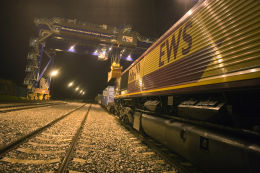Posted 21st August 2008 | No Comments
Rail freight to double by 2030 — ‘more capacity will be needed’

“These new forecasts demonstrate the urgent challenges facing the rail industry and Government in meeting the future demand for rail freight."
FREIGHT moving by rail is expected to double by 2030 and by then there will be a shortfall of capacity on many routes, according to new demand forecasts published by the Rail Freight Group and Freight Transport Association.
The forecasts show a 30% increase in tonne km from 2006 to 2015 and more than doubling by 2030. However, the growth in intermodal traffic is forecast to be very much higher: more than doubling by 2015 and a five-fold increase by 2030. This reflects continuing expansion of trade from continental Europe and further afield, plus a significant use of rail to and from new rail-connected warehouses.
These figures update the 2006 forecasts and have been produced using the GB Freight Model used by the Department of Transport. The rail freight industry, operators and customers have also been fully consulted and support these findings.
The forecasts have also been allocated to specific rail routes used at present and demand compared with existing capacity assuming no change in the number of passenger trains on those routes. Unsurprisingly, the main rail freight flows are on the routes between centres of economic activity and to and from ports.
By 2030, there is forecast to be shortfalls in capacity on many routes, even assuming no increase in passenger train numbers. The greatest shortfalls will be on the following routes:
- Up to 200 trains per day: West Coast Main Line between Crewe and London, and on the North London and London, Tilbury and Southend lines
- Up to 100 trains per day: West Coast Main line between Crewe and Glasgow, East Coast Main Line between Doncaster and London, and on routes between the Channel Tunnel and London.
- Up to 50 trains per day: between Southampton and the West Midlands.
The Rail Freight Group also says that many other routes will also have an excess of freight demand over capacity. For example, the Great Eastern mainline to Ipswich, but this could be resolved by a full upgrade of the Felixstowe-Peterborough-Nuneaton direct route.
RFG Chairman Tony Berkeley commented: “These new forecasts demonstrate the urgent challenges facing the rail industry and Government in meeting the future demand for rail freight.
“Building new capacity, be it new lines or more capacity on existing lines, takes a long time, possibly 25 years if we follow the example of the Channel Tunnel Rail Link and Crossrail. The year 2030 is only 22 years away, so the time for action in identifying overall rail capacity shortfalls and possible solutions is now!”
James Hookham, FTA Policy Director said: “UK rail freight growth has been amongst the highest in the European Union. Rail will play an increasingly prominent role in moving containers to and from ports, and we anticipate an increasing demand from many sectors of industry seeking to reduce their use of congested road networks. Continued investment in the rail network is vital to sustain trade and the economy.”
